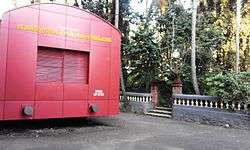Wagon tragedy
| Wagon tragedy Wagon massacre | |
|---|---|
| Part of Moplah revolt and Moplah riots | |
 Wagon Tragedy Memorial at Tirur | |
| Location | Railroad from Tirur to Podanur Junction, British India |
| Target | Moplah rebels |
Attack type | Exhumation |
| Deaths | 67 |
| Perpetrators | British India Colonial Security forces |
| Defenders | None |
The Wagon tragedy was the death of 67[1] prisoners on 20 November 1921 in the Malabar region of Kerala state of India. The prisoners had been taken into custody following Mappila Rebellion against British Colonial rule and Hindu landlords their deaths through apparent negligence discredited the British Raj and generated sympathy for the Indian independence movement.
On 10 November 1921, when the uprising was on its last breaths, almost 90 detained Muslim rebels were despatched by train from Tirur to the Central Prison in Podanur (near Coimbatore). They were bundled into a freight wagon and the train set off. Pothanur jail was found to be full to maximum capacity, so orders were given to take the prisoners back. During the return journey, 67 of the 90 rebels suffocated to death in the closed iron wagon. Historian Sumit Sarkar referred to it as the "Black Hole of Podanur".[25]
In order to attract more Muslim support to the Indian National Movement, Mahatma Gandhi and the national leaders of India initially supported the Khilafat movement and merged it to the famous Non Co-operation Movement; This succeeded in bringing almost all sections of Indians under one flag for a Pan-Indian movement for the first time.The southern Malabar district welcomed this movement in a great spirit. But in Eranad and Walluvanad taluks it took the form of an armed rebellion by Muslim Mappila community who were largely tenants being exploited by British and their supporters high caste Hindu landlords.After a series of events that culminated in violent clashes between police and protesters, Martial law was introduced and the rebellion mostly crushed. The British packed 90 prisoners into a railway goods wagon at Tirur railway station to be sent to the Podanur Coimbatore district jails. By the time they reached their destination 67 of the prisoners had died from suffocation. A monument to this notorious tragedy can be now seen at Tirur. [2]
When you consider months of torture,
the horrific incident of Wagon Tragedy of November 19–20 will seem trivial.
M. Gangadharan, Historian
Nobody then had even thought of Wagon Tragedy in Malabar as something
politically significant in all-India level.
EMS Namboothirippad, Marxist ideologue
References
2. Dr. Sivadasan.P, 'Wagon Tragedy': Kanalvazhiyile Koottakuruthi, National Book Stall, Kottayam, 2011 (ISBN 9788192282206)
External links
| Wikimedia Commons has media related to Malabar Rebellion. |
